This post is by Ritu Java, the CEO of PPC Ninja.
Amazon sellers go to great lengths to get their products ranking highly for specific keywords. They use giveaways, deep discounts, rebates, black hat tactics and aggressive advertising practices.
Collectively, these have skyrocketed the baseline cost for successfully launching products on Amazon. New sellers or brands trying to get a foothold in the search results, while staying compliant with Amazon’s terms of service, face a daunting challenge.
The good news is that Amazon Advertising is a 100% compliant way to launch products and be profitable. Amazon offers a plethora of advertising options for us to win eyeballs and sales, and these are not just limited to keyword searches.
You can win the game without spending a ton of money if you are willing to be a little creative with your Amazon PPC strategy.
The basic PPC campaign structure
There are a few different basic strategies for Amazon Sponsored Products PPC ads.
Some sellers create separate campaigns based on keyword type, such as one for brand names and another for generic product descriptions. Others break out their campaigns by search volume, separating high-volume keywords from long-tail keywords. Another strategy is to create campaigns based on research phases, running from discovery and research to “winners”.
All of these strategies tend to use a mix of automatic campaigns to generate keywords and manual campaigns to provide greater control.
Automatic campaigns can be set up with the least amount of effort on your part. Just pick a product to advertise, set a maximum bid per click and you are good to go. Amazon does most of the heavy lifting in terms of connecting buyer search terms to your ad, by identifying keywords from within your listing or from similar products.
Manual campaigns require a bit more work in that you need to do some upfront keyword research, strategize on keywords that you want your ad to be shown for, and then bid aggressively on them.
Some sellers might throw a few manual campaigns with product targeting into the mix. These target products, not keywords. They primarily show up on the detail pages of other products – which could be competitors’ products, compatible items or even products from your own catalog.
In my experience, most sellers never go beyond this basic strategy with their Amazon PPC advertising. There’s a lot more to Amazon Advertising than just a few automatic and manual Sponsored Products campaigns, and stopping at this is just leaving money on the table.
Diversify your Amazon ads portfolio
If you want to scale your business on Amazon, you’ve got to diversify your ad portfolio. Ads are a compliant way to buy search rank. By creating more ads you can:
- Steal eyeballs from your competitors’ detail pages.
- Defend your own detail pages.
- Establish relevance to Amazon’s algorithms, not only to keywords but also to products and categories.
Amazon offers a variety of ad types and placements to help sellers get more exposure on prime real estate both on and off Amazon. This includes placements that get the highest conversion rates, such as Top of Search and Video in Search.
If you are a Brand Registered seller on Amazon, then you probably have access to most of these ad types.
1. Sponsored Products:
- Automatic Targeting
- Automatic Targeting – Remarketing (Legacy)
- Manual Targeting for Keywords
- Manual Targeting for ASIN Targets
- Manual Targeting for Category Targets
2. Sponsored Brands:
- Product Collection
- Video in Search
- Store Spotlight
3. Sponsored Display:
- Views
- Searches
- Purchases
- Product Targeting
4. Advertising Console Sponsored Display:
- Interest Targeting
- Audience Targeting
5. Amazon DSP
That’s a lot of ad types! But right now, many ad placements are underutilized, because there just aren’t many players bidding on them. That’s an opportunity for you to use them in your Amazon PPC strategy.
One example of this is the Video in Search ad. This is an auto-playing infinite loop video, that provides a great way to grab attention, cheaply.
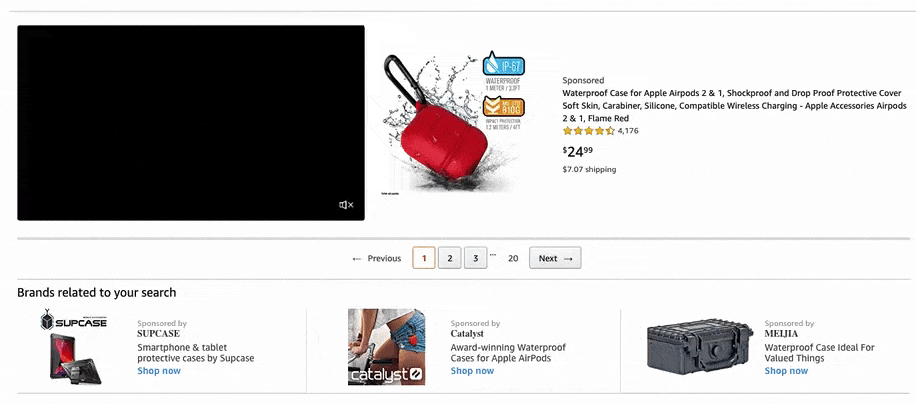
How many ads should I create?
This is a common question that gets asked a lot. I would say, the more horses you have in the race, the better. You’ve still got to keep your eye on key metrics such as ACoS and ROAS in order to stay profitable, but the more ad types you have running, the more chances you will have of finding ones that work.
A good strategy is to set up all the different types you have access to, see which ones convert well, and double down on those. Put a low bet on ones that don’t do well, but still keep them running so you get to see if the results change.
There are some real benefits to diversifying your advertising choices, such as:
- Getting more exposure in a variety of placements on and off Amazon.
- Maximizing your real estate on a single Amazon page.
- Remarketing to past buyers.
- Targeting based on audience and interests.
- Getting an early mover advantage on new ad types.
- Winning cheaper clicks on certain placements with low competition.
Because of how much work it takes to participate fully, your competition is probably not there yet, and that’s precisely why you should be.
If there is one thing I want you to walk away with from this article, it is to set up an Amazon PPC strategy for creating more ads!
How do I generate more ads?
Designing and refining ads is an ongoing process. My four-step framework for ad creation begins with understanding who the product’s avatars are, what their shopping intent might be, what awareness levels they have, and what specific ad designs or keyword hooks might match those intents.
1. Avatars
Let’s assume you are selling a garlic press. Step one is to flesh out all the possible avatars for your product. An avatar is just a type of person who might be interested in your product.
When you’ve created a list, think some more. You’ll be surprised at how many avatars you could come up with. Here’s my list:
- Foodie
- Busy homemaker
- Culinary student
- Cooking show host
- Cooking instructor
- Dietician
- Fitness freak
- Professional chef
- Occasional chef
- Restaurant owner
- Shopper looking for a gift for an occasion
- Shopper looking for a stocking stuffer
- Shopper buying for a partner who likes to cook
- Shopper looking for something unusual in the kitchen category
The reason why this list is super useful is because each avatar is coming to Amazon with a different perspective. Looking at your product from all those different points of view can be a great source of ideas for keyword research and competitor research.
2. Buyer intent
Next, you want to figure out what these people might be doing on Amazon. What is their intent – their purpose or goal – and how might that be expressed in the keywords they search for or the pages they visit?
Try to get inside the buyer’s head and meet them wherever they are on their shopping journey. Get creative and have some fun with it.
Here are some ideas I came up with:
| Buyer intent | How it might be expressed |
| Window shopping | Searched: “gift for mom” “mothers day gifts” Visited the Kitchen Gadgets page Visited the Deals page |
| Research/in-market | Recently searched for closely related kitchen items Visited a competitor page Visited a category page |
| Specific search with clear intent | Searched: “garlic press with cleaner” “garlic press with ergonomic handle” “garlic press to crush cloves” “garlic press with cheese grater” |
| Just going about life | Reading a recipe on a blog (off-Amazon) Watching a cooking show (off-Amazon) |
3. Levels of awareness
The Five Levels of Awareness were taught and promoted by Eugene Schwartz, the author of Breakthrough Advertising, and they’re really useful in anticipating how much shoppers already know about your product or brand.
Here’s how I would map those levels onto our garlic press example:
| Most Unaware | Ignorant of garlic presses in general. Someone who peels and chops garlic by hand. |
| Problem Aware | Knows that peeling garlic is messy and smelly. |
| Solution Aware | Knows of a kitchen gadget called a “garlic press” and what it generally does. |
| Product Aware | Knows there is an ergonomic garlic press made by a specific brand. |
| Most Aware | Knows about a specific brand that sells garlic presses and wants to know what new types they have come up with. |
Based on the level of awareness, your choice of keywords and messaging will be different. They can be useful in crafting custom copy where you are able to provide it, such as with Sponsored Brands and Sponsored Display ads.
4. Ad design
Once you have identified who you are targeting and what they are shopping for, it is time to put all the pieces together. Often this involves spreadsheet work, where you lay out elements like:
- Ad type
- Advertised product(s)
- Avatars
- Buyer intent
- Keywords
- Product targets
- Category targets
- Alternative headlines
- Landing pages
- Custom images
- Video concept
You can also do a bit of consolidation of avatars and keyword groups as needed. This is what my sheet looks like:
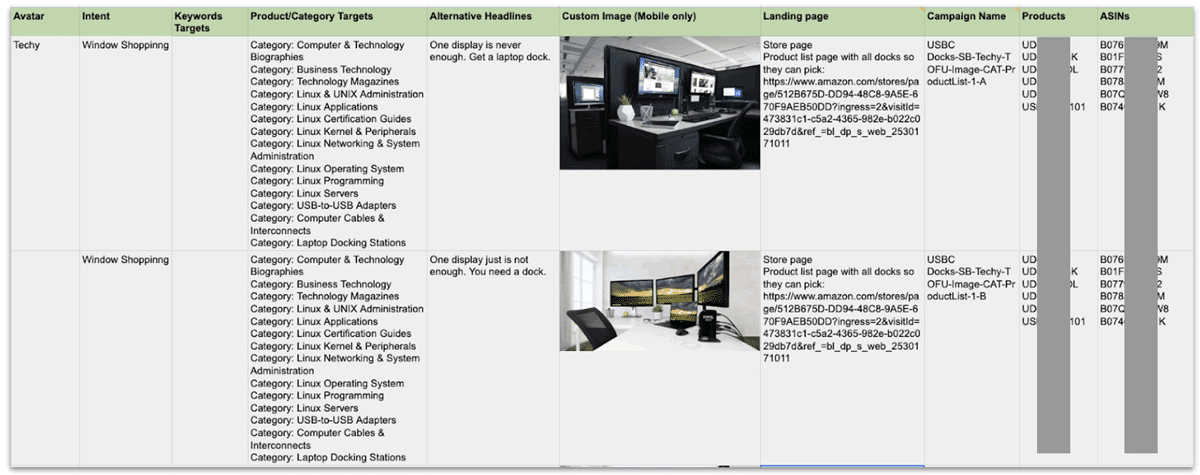
Having your whole Amazon ad plan in one place also helps when you measure and revisit PPC strategies from time to time.
Examples
Let’s look at 4 examples of ads designed using this approach.
1. Sponsored Brands
This first one is targeting professional chefs who are “solution aware”, meaning they know what a garlic press is and are actively researching using the term “stainless steel garlic mincer”.
- Avatar: Professional chef or restaurant owner
- Intent: Research on stainless steel mincer
- Awareness: Solution Aware
- Targets: “stainless steel garlic mincer”

Notice the custom message, “Heavy duty stainless steel mincer for your garlic”. The use of the words “heavy duty” speaks directly to the avatar and their requirements for a sturdy, reliable device for daily use.
Note also that you could have easily spun up another version for your “busy homemaker” avatar by simply swapping out the messaging for something lighter like “Stainless steel garlic mincer with easy cleaning.”
2. Sponsored Brands on mobile
This Sponsored Brands ad targets homemakers, and leads with a custom image of the avatar’s lookalike. This ad is for a “Problem Aware” audience. This means they know that hands could get really smelly when dealing with garlic.
- Avatar: Busy homemaker
- Intent: Window shopping
- Awareness: Problem Aware
- Targets: “kitchen”, “kitchen tool”
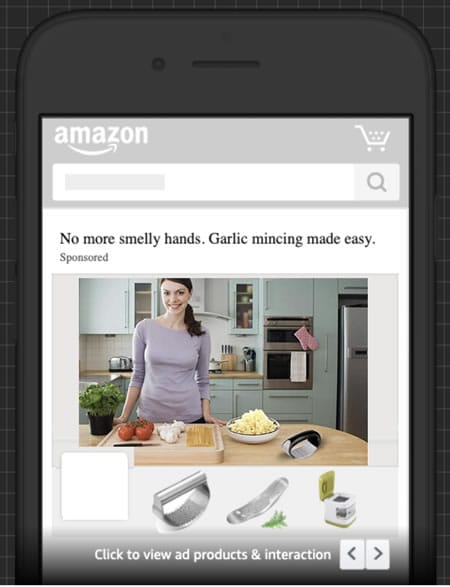
Like before, the messaging “No more smelly hands. Garlic mincing made easy.” reads the shopper’s mind and meets them where they are on their shopping journey.
This is a very different strategy to the indiscriminate keyword dumping that many advertisers are used to!
3. Sponsored Products with ASIN targeting
This next example is of a Sponsored Products ad with product targeting.
This looks just like an ordinary ad, so no custom messaging is possible. I’ve designed it for a “foodie” avatar who is Solution Aware because they are already browsing a competitor’s product detail page when they see this ad.
- Avatar: Foodie
- Intent: Researching on a competitor’s page
- Awareness: Solution Aware
- Targets: Competitor ASINs
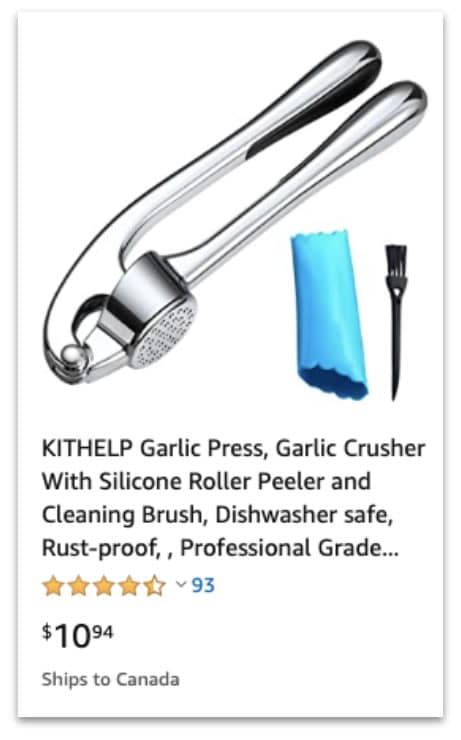
The way I find targets for this type of ad is by researching competitor ASINs in the Item Comparison report from Brand Analytics.
But there are many ways you can find products to target. Here’s a post I wrote with 10 ideas on how to identify ASINs for product targeting ads.
4. Product Display Ad
This last example is of a Product Display Ad. This type of ad can be created by vendors or sellers who have access to Amazon Advertising Console (previously AMS). It allows a custom message but not a custom image.
- Avatar: Occasional chef
- Intent: Window shopping
- Awareness: Problem Aware
- Targets: Kitchen, home
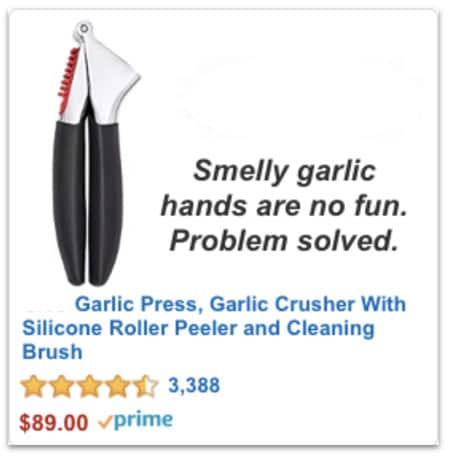
I’ve designed this ad for the “occasional chef” who is just window shopping in related categories (kitchen and home), and is aware of the problem of smelly hands.
The message “Smelly garlic hands are no fun. Problem solved.” speaks to this type of shopper. It will resonate with them and entice them to click.
Find time to work on your Amazon PPC strategy
When you spend more time working on your Amazon PPC strategy, and creating more ads, you will see better conversions and a higher ROI. You will meet shoppers where they are in their journey and be more relevant to their needs.
Ad design needs to go beyond the basic mechanics of campaign set up. You need to get into the buyer’s head and not be afraid to test out other types of ads, even those which are in their early beta testing.
Don’t forget, the good thing about PPC is that it stands for “pay-per-click”. You don’t pay anything for the ad upfront because you only get charged when someone actually clicks. Why waste the chance?
The short version: create more ads and create better ads. That’s the way to win on Amazon.
This post was by Ritu Java, the CEO of PPC Ninja, a company offering Amazon PPC tools and services to sellers, vendors and agencies.
PPC Ninja’s goal is to get advertisers better at their craft through their highly interactive PPC management software, superior strategies published regularly on their blog and on social media, as well as by participating in the virtual masterminds that PPC Ninja offers. For questions on this topic, feel free to reach out to Ritu on LinkedIn.

Leave a Reply